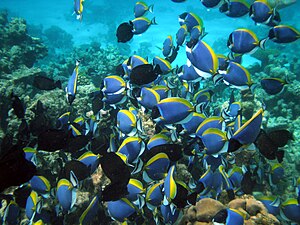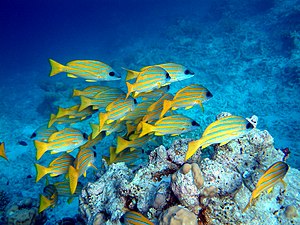
Back Bandada de peixes AN Рибен пасаж Bulgarian Mola de peix Catalan Wała rib CSB Schwarmfisch German Fiŝaro Esperanto Cardumen Spanish Kalaparv Estonian Sarda Basque دسته ماهی و توده ماهی Persian
In biology, any group of fish that stay together for social reasons are shoaling, and if the group is swimming in the same direction in a coordinated manner, they are schooling.[1] In common usage, the terms are sometimes used rather loosely.[1] About one quarter of fish species shoal all their lives, and about one half shoal for part of their lives.[2]
Fish derive many benefits from shoaling behaviour including defence against predators (through better predator detection and by diluting the chance of individual capture), enhanced foraging success, and higher success in finding a mate. It is also likely that fish benefit from shoal membership through increased hydrodynamic efficiency.
Fish use many traits to choose shoalmates. Generally they prefer larger shoals, shoalmates of their own species, shoalmates similar in size and appearance to themselves, healthy fish, and kin (when recognized).
The oddity effect posits that any shoal member that stands out in appearance will be preferentially targeted by predators. This may explain why fish prefer to shoal with individuals that resemble themselves. The oddity effect thus tends to homogenize shoals.
- ^ a b Cite error: The named reference
Pitcher 365was invoked but never defined (see the help page). - ^ Shaw, E (1978). "Schooling fishes". American Scientist. 66 (2): 166–175. Bibcode:1978AmSci..66..166S.
© MMXXIII Rich X Search. We shall prevail. All rights reserved. Rich X Search

